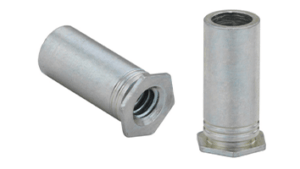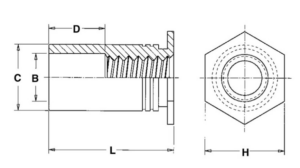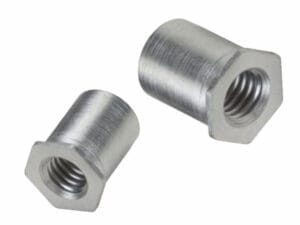In this article we’ll focus on one of the oldest methods of joining two parts: the rivet. From Egyptian spearheads to bronze age axes, and right through to current manufacturing methods, the rivet has some serious staying power. The advent of press-fit hardware has seen the rivet concept improved such that they are removable and reusable, and at SendCutSend we offer hardware Insertion services for a wide variety of materials and thicknesses to fit just about any application. Is a rivet right for your project, or is there a better alternative? What material considerations are there? Does this project call for a solid rivet, a pop rivet or a rivet nut? Answers to these questions and more can be found below, so dig in!
6 Different Types of Rivets and Their Functions
Rivets come in a wide range of sizes and shapes to fit different industries and applications. The rivet in its most basic form consists of a head and a shaft which is slightly longer than the thickness of the two pieces it will fasten. The shaft end of the “solid” rivet is inserted through pre-drilled holes, then deformed creating a second head which permanently secures the two pieces. Rivet type fasteners are excellent in shear loading, have good tensile strength properties, and are nearly immune to vibration loosening. We’ve compiled a short list of the most popular varieties to get you on your way to successful joinery.
Solid Rivet
This is the great-granddaddy of all other rivets, consisting of a simple shank or shaft with a head at one end. Solid rivets come in various profiles to fit the application; the pan head, the domed head, the low profile mushroom head (no, we aren’t making things up), and the flat head. The solid rivet is sturdy and no-nonsense, and very few fastening methods are as consistent in their ability to hold two materials together.
Blind Rivet
Commonly known as the “pop” rivet, blind rivets are especially useful when only one side of the assembly is accessible. This rivet relies on a special riveting hand tool–or pop rivet gun–which can be purchased at most home improvement or automotive stores. To install a pop rivet, the body is put through a pre-drilled hole and contacts the facing material, after which the rivet gun pulls the shaft or mandrel back through the body, deforming the far end creating a new shoulder which pulls the two sheets of material firmly against one another. There are several types of blind rivets, each having specific application in metal, fiberglass, many plastics, wood and other solid sheet materials.
Split Rivet
Split or bifurcated rivets are similar in shape to solid rivets except that the tail end of the shaft is split, allowing a special wedge tool to be used to expand the two “legs” once the rivet is inserted through the two pieces of material. Split rivets require access to both sides of the material and are typically used in softer plastics, heavy fabric and leatherwork.
Tubular Rivet
Tubular (or semi-tubular) rivets resemble a solid rivet with a hole drilled partway through the tail end of the shaft. They are installed in the same way as solid rivets–with access to both sides of the fastener being required–but only require about a quarter of the force to set the rivet. Because the tubular rivets only deform at the hollow end, rather than throughout the length of the shaft, they can be used for pivot joints.
Flush Rivet
The observant individual reading this article might assume that this means the countersunk head sits even with the surface of the workpiece. They’d be right. A hole with a countersink (typically a 100° bevel) is matched to the size of a rivet with a 100° chamfer on the shoulder. These rivets can be blind or solid, and have obvious advantages for aesthetics and aerodynamic drag characteristics (think, less turbulence on the airplane wings).
Metal Rivet Materials
Each of the rivets mentioned can be produced from various metal alloys. One of the only limitations to what material a rivet can be made of is that the shaft must be ductile enough to deform without cracking. Malleable alloys aluminum and low carbon steel are most common, along with stainless steel for added corrosion resistance, brass and copper for aesthetics and, because they are softer materials, for ease of installation without specialized equipment or heating.
If high strength is critical, high carbon steel solid rivets can be used, which require heating to “cherry red” temperature and then setting with a pneumatic rivet tool.
What are Alternatives to Rivets?
Although rivets are affordable and dependable, they are also time-consuming to install, permanent, and heavier than other fastening methods. To address some of these concerns, and deliver a solid solution for failure free fastening, SendCutSend offers PEM hardware insertion in several grades of aluminum and steel.
Press Fit Nuts
In the DIY world, by far the most popular type of rivet is the pop rivet, mainly because it can be used when you only have access to one side of your work. The biggest downside? Unless you feel like taking a drill to your shiny new project, that rivet is permanent.
Rather than specifying rivet holes in your next part, once it’s uploaded to our app select “Hardware Insertion.”

Fig. 1: Adding a press fit nut to any hole in your part is simple.
Then click “Open Catalog” and you’ll see all the available hardware options. We’ve made the process simple, so don’t worry if your specified hole is not quite the right size for your fastener–we’ll automatically resize the holes to match the hardware exactly.

Fig. 2: The 3D preview allows you to visualize the fastener and check installation direction.
Our press fit nuts are vibration resistant and won’t break loose like often happens with tack welded nuts. They can also be installed in metal sheets as thin as 0.048”.
Self-Clinching Studs
You can think of self-clinching studs as the yin to a press fit nut’s yang: like a nut, a self-clinching stud requires access to only one side of the assembly. An added benefit over a standard nut and bolt assembly is that a stud is fixed so that it cannot rotate as you lie on your back trying to thread on a nut with no visibility. Oh, that’s never happened to you? Lucky you…
Standoffs
PEM standoffs installed by SendCutSend add the ability to space two workpieces a fixed distance from one another, which is something a rivet really can’t do well. Standoffs are often used to space a printed circuit board off of the base plate, but can be used to allow airflow between two parts, or many other applications.
Another benefit of SendCutSend inserted hardware, along with our tapping service, is that they are always installed square (or perpendicular to the mounting surface). This is particularly difficult to accomplish in the home shop without specialized equipment. For an in-depth look at each type of fastener and how best to use it, take a look at our article on Designing with Sheet Metal.
Limitations of Using Rivets vs. PEM Fasteners
Time
In most cases, rivets require a pre-drilled set of holes that line up perfectly in the workpieces. Although this isn’t a problem when you make your parts with our precision lasers, it also involves selecting the correct rivets and in many cases, purchasing specialized equipment to install them.
Labor
When specifying PEM fasteners in your sheet metal from us, the amount of work per fastener is reduced to the time it takes to thread a nut or bolt.
Consistency
If you’ve ever worked with pop rivets, you know that whether it’s user error, component variability, or misalignment, there can be significant variability in the quality rivet-to-rivet.
Applications of Rivets and Fasteners
Although limitations to rivets exist, there are still many great applications across various industries: aircraft construction and sheet metal fabricators still often employ riveted joints because they are nearly immune to loosening with vibration. The RV industry uses riveting techniques to fasten materials like plastic, plywood and aluminum together–try doing that with a welded joint sometime. Further, if the proper precautions are taken, rivets can be waterproof making them the fastener of choice in many shipbuilding applications.
For a deeper dive into each of our PEM fasteners, and additional insight into how you can use them in your next build, take a look at the Hardware Guidelines, and Best Practices writeups.
Material Selection for Hardware Installation
You’ve drawn your parts up in your favorite CAD software, and while you have an idea of the details like hole size, placement, and relation to bend lines, you’re sweating it a little. Never fear! In addition to the Hardware Guidelines we linked to before (I guess we’ve done it twice now), there are also material and thickness-specific details for every compatible material. For instance, say you have decided to go with 5052 H32 aluminum because it is lightweight, strong, corrosion resistant, and affordable. If you go over to our Hardware Catalog, you can filter the available fasteners by material to see exactly which nuts, standoffs and studs you have to choose from, and if you drill down by that fastener, you can also see helpful info like max and min thickness, centerline to edge measurements, and lots more.
Solve Your Design Problems with SendCutSend’s Hardware Installation Service
Although rivets definitely have seniority in the wide world of fasteners, our hardware selection, which includes nuts, studs and standoffs offers a wider range of potential applications. Not only that, but because they employ a threaded joint, PEM hardware is completely removable if your application doesn’t call for a permanent joint. Installed fasteners, like rivets, are also extremely vibration resistant, which allows them to be used in automotive and other repetitive motion applications.
So how do you determine what fastening method is best? The answer to that depends on the application; materials, end use, environmental factors and even available equipment. What we can offer is a wide range of quality hardware pre-installed to save you time, and since they start at under $1 per fastener, a little money too!
FAQs Around Rivets
Do you want the assembly to be able to be taken apart for storage or moving? Better use hardware insertion. Are you looking for the absolute lightest weight and best vibration resistance? Go with a solid shaft rivet.
Actually, nothing! The original blind rivet was developed in Britain in 1916. During and just after WWII the POP ™ rivet exploded in popularity due to its comparative ease of use. It’s still the most popular type of rivet today, with the trademark now owned by the Stanley corporation.
While a tack weld can’t be beat for fastener weight or speed, rivets (and the rivet nut hardware we offer) have much better vibration resistance and repeatability. Plus, try welding a wood panel to an aluminum sheet sometime.







